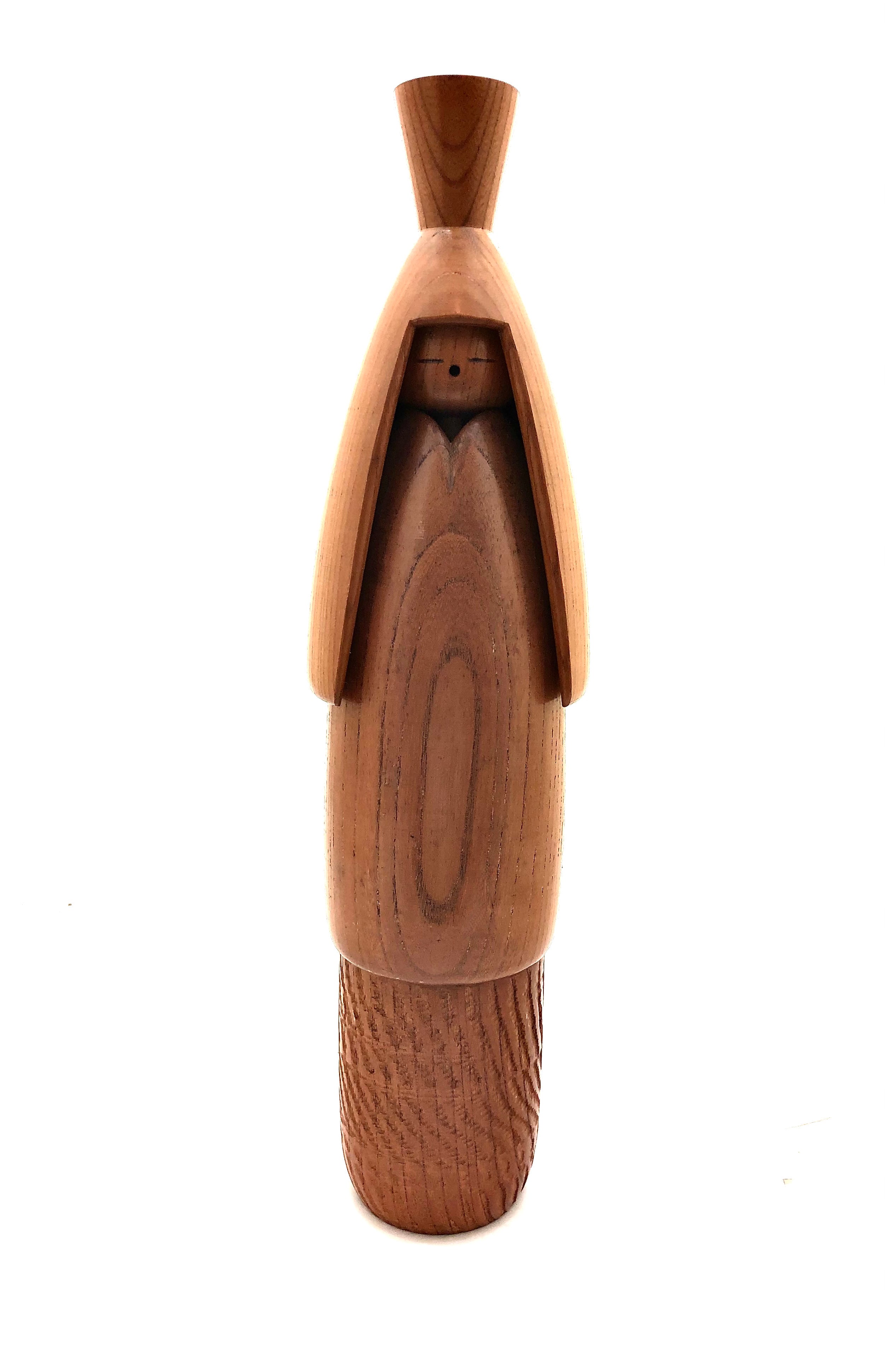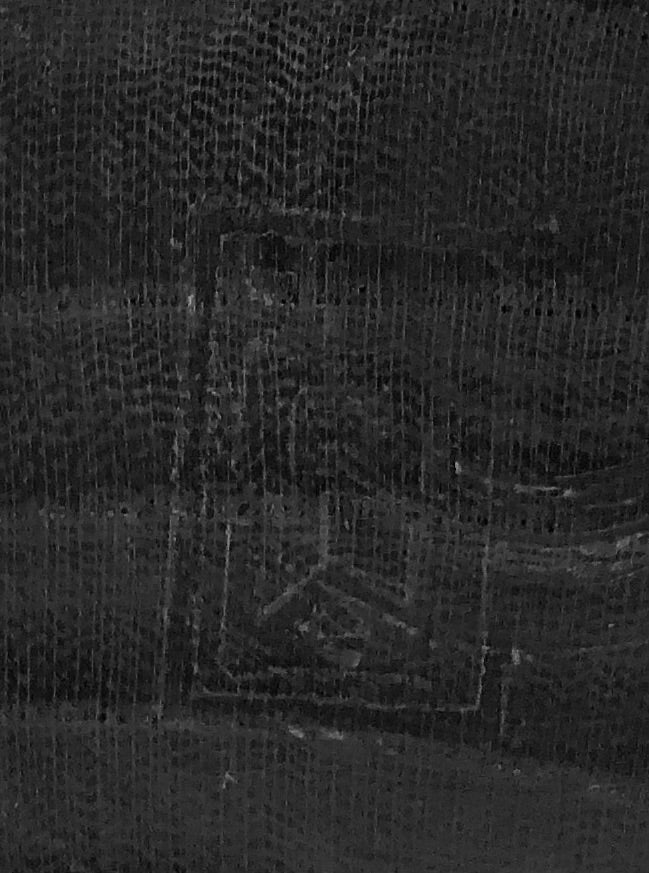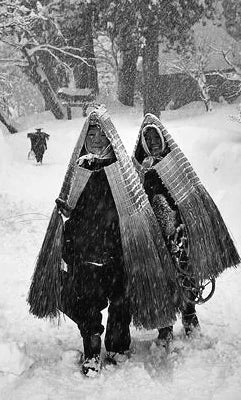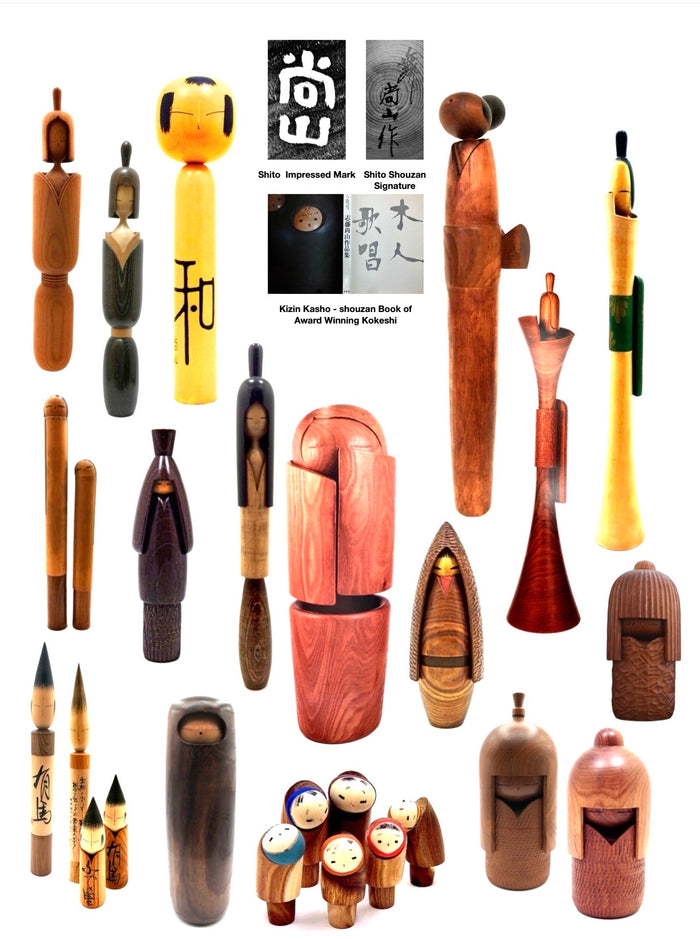


Vintage Minomushi Cape Sosaku Kokeshi entitled: "Yukiguni no Warabe | Children of the Snow Country” by Shouzan, Shido | 1932-1995
Dimensions: 16-1/4”h
The doll represents a school girl wearing an unusual straw outer-wrapping called a “Minomushi”. The doll is made of lathe-turned jointed pieces made from Elm wood, (Zelkowa / Keyaki) for which Japanese woodcarvers has always had a love of ‘nature-worship’, for wood has long been revered as a vehicle to house the spirits of Japan’s shinto beliefs.
The creative interpretation of her ‘Mino’ shows this figure to be a hooded female whose body form consists three sections: the hood, the body draped in the outer- garment and a base which is the under-garment. Her head is moveable under the hood and exhibits peaceful eyes along with an an opening representing her mouth. Its’ unique feature is the textural qualities of ‘Chattering’, (chisel bouncing and causing a heavy textural quality to the wood), and seen on the base of the doll representing the undergarment worn beneath the Kimono. The only other ornamentation seen is through the delicate carving of the various elements of the doll and through the natural lacquer finishing emphasizing the natural graining of the wood. After the turning, carving the doll is lacquered and sealed with a natural candle wax, (Rosoku no ro). A perfect doll for the collector of Shouzan’s work in the Japanese Kokeshi folk art genre.
Shouzan’s keen sense of design, minimal use of color, and simple elegant shapes set him apart from his peers, making him one of the most collectible artists emerging from the creative period. Shido won numerous awards including the prestigious Prime Minister Award. Shido-San passed away in 1995. The doll has Shouzan-san’s impressed stamp on the bottom of the doll.
Condition: Excellent with no imperfections or color loss. Museum quality piece and a perfect doll for the collector of Shouzan’s work in the Japanese Kokeshi folk art genre.
NOTE: The northern villagers have traditionally been farmers and silkworm cultivators, who, in spite of bad weather, had to move about without care. This article of outer clothing was worn to protect rural people from rain and snow, and is fashioned after an earlier version that was made of straw. These Minomushi have been conceived based on traditional pitched roofs throughout the Showa Valley region. That architectural treatment was known locally as “Te o inotte”, (praying hands), a reference to the fact that the unique roofs look like praying hands, and were built to shed the heavy snows that fall in the winter. Shouzan-sans slender, Northern tall Kokeshi figures reminded him of these architectural elements as well as the tall, thin trees seen throughout Northern Japan.

Artisan
Woodworker: Shido, Shouzan
1932-1995
Biographical History:
Shouzan began making Sosaku Kokeshi in 1959, soon after he graduated from Chuo University with a law degree. He is considered by Kokeshi collectors and critics alike to be arguably the most influential artist in the world of Sosaku Kokeshi doll-making. Shido-san’s main focus was depicting unadorned Northern girls in the traditional “Mino”, or Snow Coat, but he also produced tall, thin dolls, which were sparsely decorated. His keen sense of design, minimal use of color, and simple elegant shapes set him apart from his peers, making him one of the most collectible artists emerging from the creative period of the ‘60s winning various awards since 1961. He served as a judge of the All Japan Kokeshi Contest from 1970 to 1976. During that time Shozan published a book entitled Kizin Kasho comprising examples of his award-winning Kokeshi. His dolls have been collected and exhibited worldwide and winner of the Prime Minister’s Award, among many other awards.
Collector's note – descriptive qualities, standard characteristics & ornamentation styles:
Shito-san loved studying the use of combining different types of wood to gain the desired effect and to give dimension to his pieces. He also enjoyed creating slender, tall dolls to support the fact that they resemble the tall, thin trees seen throughout Japan. He incorporated a repetitive textural pattern called ‘Harmonic Chatter work’ to enhance the natural qualities of the wood in many of his works. He particularly enjoyed the textural qualities of ‘Chattering’ on the rain/snow coat, (Minomushi), which is a favorite theme, executed with minimal painted ornamentation, with an emphasis on the natural wood. In general, it is said that Japanese culture is one of modesty and humility. Occasionally saw different types of headdresses, one of which he called a ‘Tsunokakushi’, which is a wide headdress or hood, that covered elaborate hairstyles. We are told that the Japanese people regulate their behavior and response by reading faces and the eyes of others. Here, as well as elsewhere, you will see many examples of different characteristics of the eye's expressions. His most famous doll, which was considered a favorite was called “Mai”, a dancer, which was an elegant and slender doll with a beautifully formed Kimono focusing on traditional hair design (Mage) with an emphasis on a brightly colored “obi” which brings forth the best use of complex geometry to create traditional Japanese clothing elements which were created in 1970.
Shito-san was a prolific artist/woodworker of Kokeshi dolls some of which were whimsical, some focusing on calligraphy citing haiku (poems). We additionally see unusual subjects focused on Zen Buddhism and figures of Daruma, (Bodhidharma) of which most were made in a “roly-poly” type figure seen throughout festivals in Japan.
Explore & Learn More about Woodworker: Shido, Shouzan